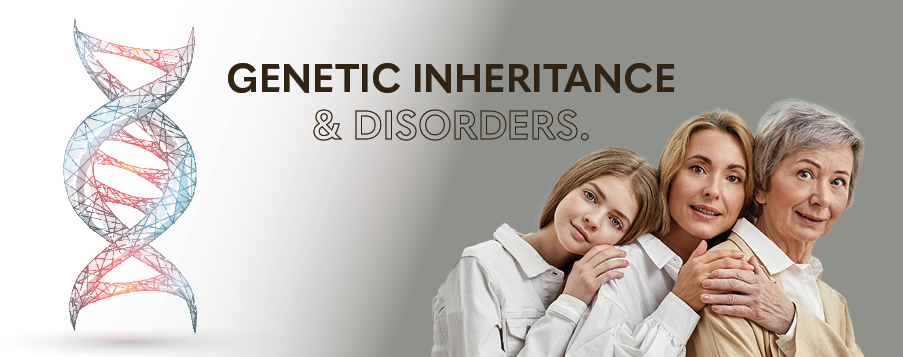14/12/2023
Understanding the intricate world of genetic inheritance and its impact on various conditions is crucial in comprehending the complexities of human health. While Mendelian disorders stem from the groundwork laid by the renowned geneticist Johann Gregor Mendel, contemporary understanding expands far beyond his original discoveries. Within the realm of genetic inheritance, the interplay of dominant and recessive alleles contributes significantly to the expression of these disorders. In this exploration, we delve into the complexities of genetic inheritance, uncovering the underlying principles that govern the inheritance patterns of a diverse array of genetic conditions.
Mendelian Genetics
Genetic conditions can be of 1 of 2 categories: Mendelian, those which are influenced by a single gene, and Complex, or polygenic, meaning those influenced by multiple genes. Like most traits, for example, eye or hair colour, most conditions are not caused by something as simple as a single variant, rather many variants all displaying a modest effect, culminating in the development of a trait or genetic disorder. These conditions are named complex for a reason; we still don’t know how many of them come about. However, we have identified many of the variants associated with these conditions and through equally complex algorithms, can calculate your risk of developing them.
Mendelian disorders are a little simpler, although not much. They get their name from Johann Gregor Mendel, who is dubbed by many to be the father of modern genetics. He gets this title from his work on inheritance; he discovered that traits are passed from one generation to the next, not mixed to create a hybrid of the traits.
Now that history class is finished… time for a science lesson. In every cell in your body are 23 pairs of chromosomes inherited from your parents that contain your DNA and dictate everything about you. Each chromosome contains a version of each gene, individually referred to as alleles. Alleles can be dominant or recessive and each allele may consist of a different variant.
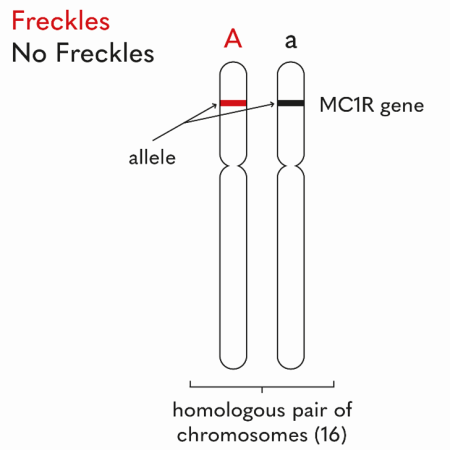
Unlike Mendelian traits, where the pattern of inheritance is dictated by dominant or recessive alleles of a single gene, polygenic traits typically do not exhibit a clear-cut dominant or recessive pattern. Instead, they are influenced by the cumulative effects of multiple genetic and environmental factors.
There are several types of Mendelian inheritance patterns related to genetic conditions:
1 altered copy of the gene is enough to cause the disorder. These conditions can be inherited from an affected parent or can occur as a new variant in the gene i.e., there’s no family history of the disorder. Familial Hypercholesterolemia is an example of an autosomal dominant condition2.
For a person to be affected, they must harbour the pathogenic variant in both copies of the gene. The parents of this individual will both have been carriers of the variant but normally are not affected by the condition and these disorders are not typically seen in all generations. Haemochromatosis types 1, 2 and 3 are examples of autosomal recessive conditions3.
These are conditions caused by variants found on the X chromosome. Males, who have only 1 copy of X, require only one copy of the pathogenic variant to be affected. In females, only 1 copy of their 2 X chromosomes must carry the variant to be affected. There is no male-to-male transmission as fathers pass on their Y chromosome to their sons; boys get their X chromosome from their mothers. Fragile X syndrome is an example of this type of inheritance4.
As before, males only require one copy of the variant to be affected. However, females require 2 copies of the pathogenic variant. An example is red-green colour blindness5. This means these conditions are more common in males than females. Again, there is no male-to-male transmission.
NOTE: Many X-linked conditions are not clearly dominant or recessive and are often simply called X-linked. In males, 1 pathogenic variant will cause disease, however, in females, 1 pathogenic variant may cause them to be unaffected or it may cause a less severe form of the condition compared with females with 2 pathogenic variants or affected males. X-linked thrombocytopenia, a condition which affects blood clotting, is an example4.
The pathogenic variant occurs on the male Y chromosome meaning females cannot get it and it can only be passed from father to son. Y-chromosome infertility is an example4.
In this form of inheritance, 2 alleles of a gene are expressed, each having an influence on the status of the condition. ABO blood grouping works in this way – the alleles for A and B are codominant and O is recessive, therefore your blood group may be A or B as dominant, AB as codominant or O as recessive traits4.
This inheritance applies to mitochondrial DNA. It is named maternal as it is only the mother who contributes mitochondria, the molecules responsible for cellular energy, to the embryo. Therefore, both males and females can be affected by these conditions, but they can only be passed to the next generation by females. An example is Pearson syndrome6.
Inheritance
Now that we understand how dominant and recessive alleles affect disease, the next thing to look at is the probability that a particular allele will be inherited from the parents. The simplest way to explain this is to visualise it with what’s called a Punnett square, named after the geneticist, Reginal Punnett.
But first, we’ll need to define a few more terms:
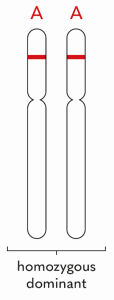

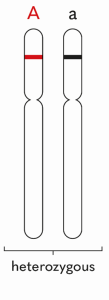
Punnett Squares For Freckles:
Where both parents are homozygous dominant, there is a 100% chance that the progeny will have freckles.
This will also be the case for homozygous dominant & homozygous recessive or heterozygous expression as there will always be a dominant allele in each box of the Punnet square. Try drawing it for yourself if you don’t believe it.

The progeny of 2 heterozygous parents will have a 75% chance of having freckles as the dominant allele always prevails over the recessive.

Where one parent, in our example the father, is homozygous recessive, and the other is heterozygous, there will be a 50% chance the progeny will have freckles.
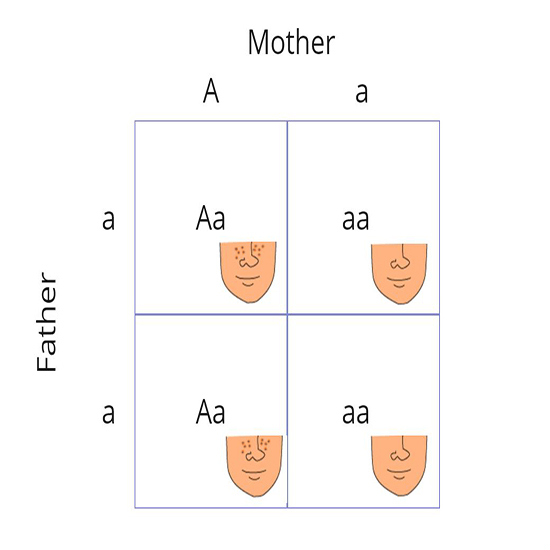
Finally, the progeny of the homozygous recessive parents will have a 0% chance of having freckles.
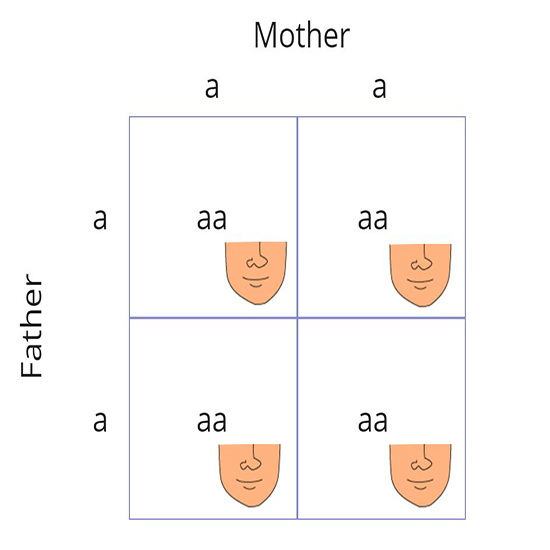
In reality, it isn’t quite as simple as this. There are also other factors at play which can change your genetic makeup. Errors in DNA replication can alter genes and result in new alleles being formed, showing just one of the ways in which genetic mutation can occur during development.
Regarding polygenic traits, they will be influenced by the varying combinations of dominance, and there may be more than simply 2 types of alleles, for example with the ABO blood group. There’s also the issue of codominance that we’ve already mentioned, as well as other exceptions to the rule.
To see how these inheritance patterns relate to specific genetic conditions, have a look at our blog Unzip your genes and discover how genetic testing at Randox Health could benefit you. Feel free to view our range of genetic tests or book an appointment at https://randoxhealth.com/genetic-testing.
- Bastiaens M. The melanocortin-1-receptor gene is the major freckle gene. Hum Mol Genet. 2001;10(16):1701-1708. doi:10.1093/hmg/10.16.1701
- Vaezi Z, Amini A. Familial Hypercholesterolemia. StatPearls Publishing; 2022.
- Porter JL, Rawla P. Hemochromatosis. StatPearls Publishing; 2023.
- National Library of Medicine. What are the different ways a genetic condition can be inherited? Medline Plus. Published April 19, 2021. Accessed October 18, 2023. https://medlineplus.gov/genetics/understanding/inheritance/inheritancepatterns/
- National Library of Medicine. Color vision deficiency. Medline Plus. Published January 1, 2015. Accessed October 18, 2023. https://medlineplus.gov/genetics/condition/color-vision-deficiency/#inheritance
- Chinnery PF. Primary Mitochondrial Disorders Overview.; 1993.

